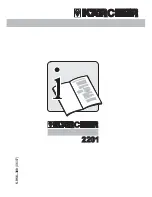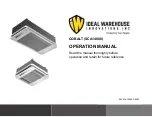
English |
21
The dust extractor may be used for vacuuming and extract-
ing the following materials:
– Dusts with an exposure limit of > 1 mg/m
3
u
Products that are only sold in AUS and NZ:
Use a resid-
ual current device (RCD) with a nominal residual current
of 30 mA or less.
The dust extractor must categorically not be used in poten-
tially explosive areas.
To ensure optimum suction power, you must always fully un-
wind the vacuum hose
(21)
from the top part of the dust ex-
tractor
(8)
.
Dry vacuuming
Vacuuming up dust deposits
– To
switch on
the dust extractor, set the
mode selector switch
(5)
to the "extraction"
symbol.
– To
switch off
the dust extractor, set the
mode selector switch
(5)
to the "switch off"
symbol.
Extracting dust that accumulates from working power
tools (see figure H)
u
There must be a sufficient air exchange rate (L) in the
room when the exhaust air comes back into the room.
Be aware of the corresponding national regulations.
The dust extractor has a plug socket with a protective earth
contact
(3)
that can be used to connect an external power
tool. Observe the maximum permitted connected load of the
connected power tool.
– Fit the extraction adapter
(19)
– Insert the dust extraction adapter
(19)
into the extraction
outlet of the power tool.
Note:
When working with power tools that have a low air
feed into the vacuum hose (e.g. jigsaws, sanders, etc.), the
false air intake
(32)
of the dust extraction adapter
(19)
must
be opened. Only then can the semi-automatic filter cleaning
(SFC+) system work without any problems.
To do this, turn the ring above the false air intake
(32)
until
the opening is at its maximum size.
– To
activate the automatic start/stop
function of the dust extractor, set the
mode selector switch
(5)
to the "auto-
matic start/stop" symbol.
– To
activate
the dust extractor, switch on the power tool
that is plugged into the electric socket
(3)
. The dust ex-
tractor will start automatically.
– To
stop
dust extraction
, switch the power tool off.
The automatic start/stop run-on function will run for up
to 15 seconds longer in order to extract the remaining
dust from the vacuum hose.
– To
switch off
the dust extractor, set the
mode selector switch
(5)
to the "switch
off" symbol.
Wet vacuuming
u
Do not use the vacuum cleaner to vacuum combustible
or explosive liquids, such as petrol, oil, alcohol or
solvents. Do not vacuum hot, burning or explosive
dust. Do not operate the vacuum cleaner in areas sub-
ject to explosion hazards.
Dust, vapours and liquids can
ignite or explode.
u
The vacuum cleaner must not be used as a water
pump.
The vacuum cleaner is designed for vacuuming air
and vacuuming water mixtures.
Note:
The requirements for the degree of penetration (dust
class L) have only been verified for dry vacuuming.
Steps to Take before Wet Vacuuming
– Remove the disposal bag
(23)
or dust bag if necessary.
Note:
Use a wet filter bag (accessory), which separates li-
quid from solids, to make disposal easier when vacuuming
water-solid mixtures.
– Place the rubber lip
(26)
into the floor nozzle
(28)
Fitting the rubber lip (wet vacuuming) (see figure
– Switch off semi-automatic filter cleaning (SFC+) (see
"Semi-automatic filter cleaning (see figure
Vacuuming up liquids
– To
switch on
the dust extractor, set the mode selector
switch
(5)
to the "extraction" symbol.
The dust extractor is equipped with fill level sensors
(35)
.
The dust extractor shuts down if the maximum fill level has
been reached. Set the mode selector switch
(5)
to the
"switch off" symbol.
Note:
When extracting non-conductive liquids (e.g. drilling
emulsion, oils and fats), the dust extractor will not switch off
when the container is full. The fill level must be constantly
monitored and the container emptied in good time.
– To
switch off
the dust extractor, set the mode selector
switch
(5)
to the "switch off" symbol.
– Empty the container
(1)
.
To prevent mould growth after wet vacuuming:
– Remove the flat-pleated filter
(24)
and leave this to dry
thoroughly.
– Remove the top part of the dust extractor
(8)
, open the
filter cover
(34)
and leave both elements to dry thor-
oughly.
Semi-automatic filter cleaning (see figure I)
The filter cleaning function should be used regularly, and at
the very latest when the suction power is no longer suffi-
cient.
How often filter cleaning needs to be carried out will depend
on the type and quantity of dust that has been extracted.
With regular use, the maximum conveying capacity will be
maintained for longer.
During semi-automatic filter cleaning (SFC+), the air flow is
reversed to clean deposited dust from the flaps of the flat-
pleated filter.
Bosch Power Tools
1 609 92A 7Z7 | (23.06.2022)
Summary of Contents for 3 601 JC3 060
Page 4: ...4 20 21 25 22 24 23 3m 27 26 19 29 28 19 20 21 22 1 609 92A 7Z7 23 06 2022 Bosch Power Tools ...
Page 7: ... 7 J1 J2 K 34 14 24 24 35 35 Bosch Power Tools 1 609 92A 7Z7 23 06 2022 ...
Page 8: ...8 L 22 29 13 15 16 25 28 17 4 1 609 92A 7Z7 23 06 2022 Bosch Power Tools ...
Page 250: ...IV 1 609 92A 7Z7 23 06 2022 Bosch Power Tools ...
















































